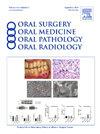口腔软组织及颌骨肉瘤(OSTJS):两所医院128例临床病理回顾性分析
IF 1.9
3区 医学
Q2 DENTISTRY, ORAL SURGERY & MEDICINE
Oral Surgery Oral Medicine Oral Pathology Oral Radiology
Pub Date : 2025-07-21
DOI:10.1016/j.oooo.2025.04.053
引用次数: 0
摘要
头颈肉瘤是一种异质性的恶性间充质肿瘤,占所有头颈癌的1%-2%,占成人所有肉瘤的4%-10%。头颈部肉瘤具有侵袭性生物学行为,5年生存率为46%-60%。关于OSTJS的研究很少。我们将介绍两所学术机构与OSTJS的合作经验。材料与方法从俄亥俄州立大学和明尼苏达大学口腔病理服务电子实验室数据库中检索2000-2022年的OSTJS病例。记录患者年龄、性别、解剖部位、组织病理学亚型。对梭形细胞癌或髓系肉瘤信息不全或诊断不完全的病例排除在外。结果128例OSTJS患者中,原发123例(96.1%),转移5例(3.9%)。男性77例(60.2%),女性51例(39.8%),年龄范围:4-102岁。下颌(48,37.5%)、上颌骨(39,30.4%)、牙龈(15,11.7%)、上颚(13,10.2%)和舌头(4,3.1%)是受欢迎的部位。OSTJS以成人为主(113,88.3%);平均年龄:52.2岁),只有15例儿科病例(11.7%;年龄范围:4-18岁,平均12.8岁)。儿童OSTJS除1例外均为骨内OSTJS(14.93.3%)。儿童OSTJS包括骨肉瘤(8例,53.3%)、尤文氏肉瘤(4例,26.7%)、间充质软骨肉瘤、TFCP2::EWSR1横纹肌肉瘤和肺泡软组织肉瘤各1例(6.7%)。在成人中,最常见的肿瘤是骨肉瘤(58,51.3%),卡波西肉瘤(KS;横纹肌肉瘤和未分化多形性肉瘤各4例(3.5%),平滑肌肉瘤18例(15.9%),平滑肌肉瘤7例(6.2%),软骨肉瘤6例(5.3%),血管肉瘤5例(4.4%)。最常见的口腔软组织肉瘤是KS(18 / 39, 46.2%)。结论sostjs少见,以40 ~ 10岁男性下颌骨为主。骨肉瘤是儿童和成人的主要肉瘤。虽然OSTJS主要是原发肿瘤,但转移到口腔的肉瘤可能很少发生。本文章由计算机程序翻译,如有差异,请以英文原文为准。
Oral soft tissue and jawbone sarcomas (OSTJS): a retrospective clinicopathologic analysis of 128 cases from two institutions
Introduction
Head/neck sarcomas comprise a heterogeneous group of malignant mesenchymal neoplasms accounting for 1%-2% of all head/neck cancers and 4%-10% of all sarcomas in adults. Head/neck sarcomas exhibit aggressive biologic behavior with 5-year survival of 46%-60%. Studies regarding OSTJS are scarce. We present the collaborative experience with OSTJS from two academic institutions.
Materials and Methods
Archived OSTJS cases (2000-2022) were retrieved from the electronic laboratory databases of the oral pathology services at Ohio State University and University of Minnesota. Patient age and gender, anatomic site, and histopathologic subtype were recorded. Cases with incomplete information and/or diagnosis of spindle cell carcinoma or myeloid sarcoma were excluded.
Results
From a total of 128 OSTJS cases, 123 (96.1%) were primary and 5 (3.9%) metastatic. Seventy-seven (60.2%) cases affected men and 51 (39.8%) women (age range: 4-102 years). Favored sites included the mandible (48, 37.5%), maxilla (39, 30.4%), gingiva (15, 11.7%), palate (13, 10.2%), and tongue (4, 3.1%). OSTJS showed a predilection for adults (113, 88.3%; mean age: 52.2 years) with only 15 pediatric examples (11.7%; age range: 4-18 years, mean: 12.8 years). All but one pediatric OSTJS were intraosseous (14, 93.3%). The pediatric OSTJS included osteosarcoma (8, 53.3%), Ewing sarcoma (4, 26.7%), and 1 each (6.7%) of mesenchymal chondrosarcoma, TFCP2::EWSR1 rhabdomyosarcoma, and alveolar soft part sarcoma. In adults, the most frequent tumors were osteosarcoma (58, 51.3%), Kaposi sarcoma (KS; 18, 15.9%), leiomyosarcoma (7, 6.2%), chondrosarcoma (6, 5.3%), angiosarcoma (5, 4.4%), and 4 each (3.5%) of rhabdomyosarcoma and undifferentiated pleomorphic sarcoma. The most common oral soft tissue sarcoma was KS (18 of 39, 46.2%).
Conclusions
OSTJS are uncommon with a strong predilection for the jawbones of males in their 4th decade. Osteosarcoma is the predominant sarcoma in both the pediatric and adult populations. Although OSTJS are chiefly primary tumors, metastatic sarcomas to the oral cavity may infrequently occur.
求助全文
通过发布文献求助,成功后即可免费获取论文全文。
去求助
来源期刊

Oral Surgery Oral Medicine Oral Pathology Oral Radiology
DENTISTRY, ORAL SURGERY & MEDICINE-
CiteScore
3.80
自引率
6.90%
发文量
1217
审稿时长
2-4 weeks
期刊介绍:
Oral Surgery, Oral Medicine, Oral Pathology and Oral Radiology is required reading for anyone in the fields of oral surgery, oral medicine, oral pathology, oral radiology or advanced general practice dentistry. It is the only major dental journal that provides a practical and complete overview of the medical and surgical techniques of dental practice in four areas. Topics covered include such current issues as dental implants, treatment of HIV-infected patients, and evaluation and treatment of TMJ disorders. The official publication for nine societies, the Journal is recommended for initial purchase in the Brandon Hill study, Selected List of Books and Journals for the Small Medical Library.
 求助内容:
求助内容: 应助结果提醒方式:
应助结果提醒方式:


